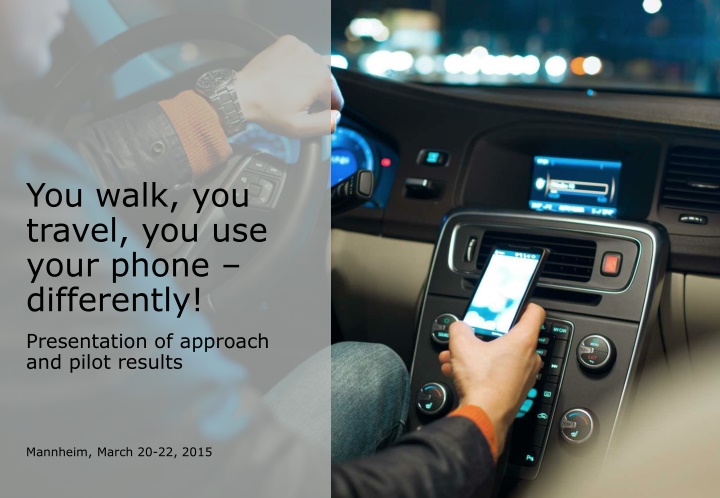
App Usage Patterns Based on Movement Speed
Explore the impact of movement speed on app usage patterns through a combination of data analysis methods, including Generalized Linear Models and Random Forests. Discover how customers engage with different app types while stationary or on the move, with insights on the influence of speed on navigation, streaming, shopping, gaming, and other app categories.
Download Presentation

Please find below an Image/Link to download the presentation.
The content on the website is provided AS IS for your information and personal use only. It may not be sold, licensed, or shared on other websites without obtaining consent from the author. If you encounter any issues during the download, it is possible that the publisher has removed the file from their server.
You are allowed to download the files provided on this website for personal or commercial use, subject to the condition that they are used lawfully. All files are the property of their respective owners.
The content on the website is provided AS IS for your information and personal use only. It may not be sold, licensed, or shared on other websites without obtaining consent from the author.
E N D
Presentation Transcript
You walk, you travel, you use your phone differently! Presentation of approach and pilot results Mannheim, March 20-22, 2015
0 Approach By combining different data sources, we can link App Usage to locations GLM and Random Forests used to analyze impact You walk, you travel, you use your phone differently? We can track Customer Movement and link it to App Usage based on time intervals What do we do, when we are not moving? What do we do, when we are on the move? Our expectation is to find different patterns of App Usage, when a customer remains in the same place or travels at different speed levels We want to test our hypothesis based on Binomial GLMs per App Type 1 A Random Forest to evaluate the overall importance of the travelling speed compared to other influential drivers (e.g. age or gender) 2 2
1 GLM Results GLM data show significant effects for various app types, suggesting a relevant impact of speed of travel on app usage patterns Key Results1) Proportion of navigation app usage 5% 0% No Travel Walking Speed 5-50 km/h 50 km/h Pedestrians are least likely to use navigation services Customers travelling at more than 50 km/h use them twice as much 30% less likely to use streaming products 25% less likely to shop online 25% less likely to play games and 18% more likely to use Photo apps Customers are most likely to make calls when traveling at 10-50 km/h 1) Evaluation based on a GLM predicting the likelihood to use the respective App categories. Models use a binomial distribution with a logit-link 4
2 Random Forest Results Random Forests have confirmed the relative importance of Speed of Movement in determining App Usage as third most important Method: Random Forest Results: Variable Importance [%] 60 AGE Employment Employment 40 Speed Cluster Device Type Speed Cluster Gender 20 0 Age Employment Speed Cluster Device Gender Speed Clusters are confirmed as third most important influential driver However, Age and Employment are the most crucial variables in determining App Usage Random Forests use a combined evaluation of a multitude of decision trees Decision Trees are randomized in each iteration, with respect to included cases and variables Based on these iterations, an overall variable importance can be computed 5
